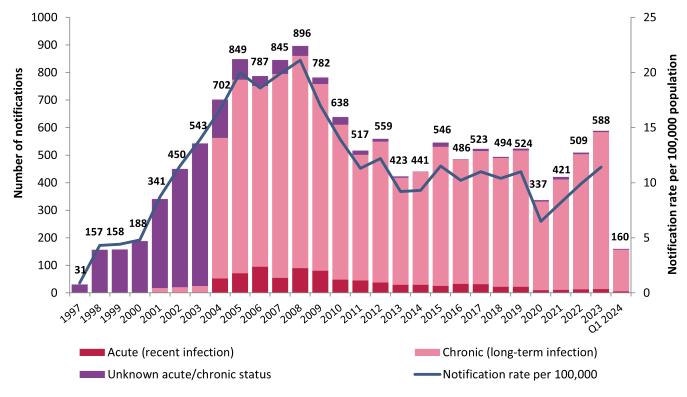Hepatitis B
Hepatitis B
Hepatitis B is a viral infection, which causes inflammation of the liver. The most common ways people become infected with hepatitis B are; sexual contact with an infected person, transmission from an infected mother to her baby around the time of birth, and sharing needles and other drug equipment by people who inject or use drugs. Over 90% of adults clear the hepatitis B virus within six months of infection. However, most babies who become infected develop chronic (long-term) infection. This can cause them to develop serious liver disease, such as cirrhosis (scarring of the liver) and liver cancer as adults. Liver damage usually occurs gradually over 20-30 years in people with chronic infection. Most hepatitis B cases notified in Ireland are in people who have immigrated to Ireland from countries with a higher prevalence of hepatitis B. Many were infected at birth or in early childhood and developed chronic infection. Hepatitis B became a notifiable disease in Ireland in 1981.
Hepatitis B is preventable by vaccination. The hepatitis B vaccine was added to the primary immunisation schedule in Ireland in October 2008, for children born from 1st July 2008. Vaccination is also recommended for adults who are in “at risk” groups. For more details on vaccination, please see Immunisation Guidelines for Ireland: Chapter 9.
Number of hepatitis B notifications and notification rate per 100,000 population, 1997- Q1 2024

Last updated: 18 June 2024
Epidemiology of Hepatitis B in Ireland, Trends up to Q1 2024
09, Jul 2024
1.75 MB
A selection of the following Hepatitis B leaflets are also available in other languages. Click here to view the leaflets in Albanian, Arabic, Chinese, Dari, French, Georgian, Russian, Somali, Ukrainian and Urdu.
Hepatitis B and You - What you need to know when you are newly diagnosed
01, Jul 2017
180.29 KB
Hepatitis B - What you need to know when you are diagnosed with chronic Hepatitis B
01, Jul 2017
258.64 KB
Hepatitis B - Someone you know has hepatitis B
01, Jul 2017
181.02 KB
Hepatitis B - You and Your Baby
01, Jul 2017
1.12 MB
Hepatitis B - Information for people with an intellectual disability, their families and carers
01, Jul 2017
185.4 KB
Hepatitis B Vaccine - What you need to know
01, Jul 2017
257.47 KB
Immunisation Information
Information on immunisation is available from the HSE National Immunisation Office
Guidance
Standard Operating Procedure (SOP) for Public Health Management of Cases and Contacts of Acute Hepatitis B
28, Apr 2025
456.9 KB
Algorithm: Public Health Management of case of Acute Hepatitis B
04, Apr 2025
136 KB
Algorithm: Public Health Management of close contacts of Acute Hepatitis B
04, Apr 2025
166.09 KB
Drug-related bloodborne viruses in Ireland, 2018
This report summarises what is currently known about hepatitis B, hepatitis C and HIV in drug users in Ireland. Trends in drug use and in drug treatment services are also described. Gaps in knowledge and opportunities for improvement in the way information is collected or recorded are highlighted.
01, Sep 2018
727.41 KB
**UNDER REVIEW** The Prevention of Transmission of Blood-borne Diseases in the Health-care Setting (2005)
This document, published by the Department of Health and Children in 2005, is currently under review
01, Jan 2025
841.46 KB
Epi-Insight Articles
Eliminating Hepatitis B and C in Ireland - Epi Insight, Volume 24, Issue 7, October 2023
World Hepatitis Day, 28th July 2015: Trends in hepatitis B and C in Ireland - Epi Insight, Volume 16, Issue 7, July 2015
Prevention of perinatal transmission of hepatitis B - Epi Insight, Volume 12, Issue 7, July 2011
World Hepatitis Day 28 July 2011 - Epi Insight, Volume 12, Issue 7, July 2011
Epidemiology of Hepatitis B in Ireland - Epi-Insight, Volume 9, Issue 9, September 2008
Hepatitis B reactivation in a dialysis unit - Epi-Insight, Volume 8, Issue 6, June 2007
Epidemiology of hepatitis B in Ireland - Epi-Insight, Volume 8, Issue 1, January 2007
Hepatitis B Transmission in Care Homes in Belgium and US - Epi-Insight, Volume 6, Issue 4, April 2005
Epidemiology of Hepatitis B Infection in Ireland - Epi-Insight, Volume 4, Issue 5, August 2003
Hepatitis B Surveillance in Southern Health Board Region - Epi-Insight, Volume 4, Issue 4, April 2003
Last updated: 08 November 2023
Journal Articles
Follow up on infants born to women with hepatitis B in the National Maternity Hospital - Irish Medical Journal, Volume 108, Issue 5, May 2015
Nosocomial outbreak of hepatitis B virus infection involving two hospitals in the Republic of Ireland - Journal of Hospital Infection, Volume 78, Issue 4, August 2011 [abstract]
Hepatitis B immunisation programmes in European Union, Norway and Iceland: Where we were in 2009? - Vaccine, Volume 28, Issue 28, June 2010
Hepatitis B reactivation in an Irish dialysis unit, 2005 - Eurosurveillance, Volume 12, Issue 4, April 2007
Last updated: 10 July 2015
Case definition
Clinical criteria
Not relevant for surveillance purposes
Laboratory criteria
Acute case
At least one of the following three:
- Detection of hepatitis B core IgM (anti-HBc IgM)
- Detection of hepatitis B surface antigen (HBsAg) AND previous negative HBV
markers less than 6 months ago
- Detection of hepatitis B nucleic acid (HBV-DNA) AND previous negative HBV
markers less than 6 months ago
Chronic case
At least one of the following two:
- Detection of HBsAg or HBV-DNA AND no detection of anti-HBc IgM (negative result)
- Detection of HBsAg or HBV-DNA on two occasions that are 6 months apart
Case of unknown status
Any case which cannot be classified according the above description of acute or chronic infection and having positive results of at least one of the following tests:
- Hepatitis B surface antigen (HBsAg)
- Hepatitis B e antigen (HBeAg)
- Hepatitis B nucleic acid (HBV-DNA)
Epidemiological criteria
Not relevant for surveillance purposes
Case classification
A. Possible case
NA
B. Probable case
NA
C. Confirmed case
Any person meeting the laboratory criteria
Note:
The following combination of lab tests shall not be included or notified:
- Resolved hepatitis - Hepatitis B total core antibody (anti-HBc) positive and hepatitis B surface antigen (HBsAg) negative
- Immunity following vaccination - Hepatitis B total core antibody (anti-HBc)
negative and hepatitis B surface antibody (anti-HBs) positive
Elevated levels of IgM in some chronic cases may result in misclassification which could over-estimate the number of acute cases
Current as of: 28 May 2018



